Icewind Dale: Rime of the Frostmaiden is all about horror and eerie encounters in the snowy wastes—with a few lighthearted interludes thrown in to keep the tone adventurous. Still, just like how reading the Wikipedia summary of a horror movie isn’t scary, running a horror encounter as-written isn’t enough to scare and excite your players. As a DM, you need to know how to create a mood of dread with your words, your atmosphere, and your players’ buy-in.
Creating Horror through Voice
The main way that Icewind Dale: Rime of the Frostmaiden creates horror is through words. It’s a book, after all, that makes sense! Many of the right words have been handed to you on a silver platter, through boxed text and in descriptive text. If you want to know how to say words in a way that absolutely drips with malice and malevolence, listen to films and radio dramas by the old masters of horror: Boris Karloff, Christopher Lee, Peter Cushing, and Vincent Price, to name just a few. Try to emulate the way they say words. Feel the weight and cheeky darkness that fills every syllable. Listen for the timing of their phrases, how they pause ever so slightly upon certain words to add drama to what they’ll say next.
Their delivery may feel campy or overwrought these days, but D&D is a game well-suited to a little bit of B-movie cheese. Rime of the Frostmaiden may have been inspired by films like The Thing and books like At the Mountains of Madness, but you can use your words and tone of voice alone to inject some gently campy, Hammer Horror-style spookiness into your game.
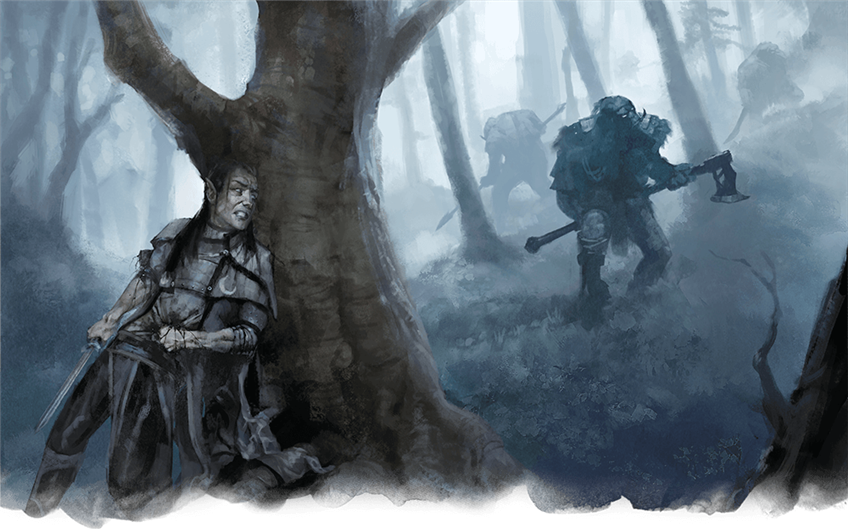
Creating Horror through Atmosphere
Music, temperature, isolation, and lighting all contribute to horror. Imagine watching a scene from your favorite movie, but the quiet, discomfiting soundtrack of discordant strings and atonal bells is replaced with silence. Even though silence can be scary in its own right, it can feel like there’s something missing. Music is a powerful tool in the hands of a Dungeon Master, and you can use it to create tension, pulse-pounding panic, or any number of other powerful emotional sensations within your players. Using tools like Syrinscape or even just an MP3 player hooked up to a Bluetooth speaker can transform your gaming room into a chamber of claustrophobic horror.
By using lights, you can amplify this effect even further. Colored LEDs are somewhat over-the-top, but by installing a few color-changing lights, you can invoke the chilly blues of Icewind Dale when your players venture onto the ice fields, or turn up a warm red tone when they’re relaxing in an inn in Ten-Towns. You can even use the transition between “normal” lighting and colored lighting to mark when you’re playing and everyone should focus versus pre-game, post-game, and break time.
Of course, if using color-changing lights is an unnecessary extravagance, you can still use lights to create tension. Keeping a light above your table, and dimming the lights around your table, can create the feeling of being in a smaller space than you actually are. That alone can be enough to evoke feelings of fear—or at least of the game being “serious business.”
If you’re playing D&D remotely—as many people are during the COVID-19 pandemic—it may be hard to create an immersive atmosphere of eerie darkness and isolation. This is mostly because players are sitting in the comfort of their own rooms, in bright lights, and there’s no spooky music being piped into their headphones. But it’s also because playing D&D digitally is inherently distracting. It’s hard for players to focus in and hang upon your every haunting word when they have a web browser open, there are pets or family members vying for their attention, and the clutter of their everyday lives are intruding upon their gaming space.
If you’re in this unfortunately (and likely) circumstance, focus on highlighting the immersive elements that you can control. During play, use your video call service (like Zoom or Discord) to send your players images of the dark, frigid, and agoraphobic wastes of Icewind Dale, and of the grisly and gruesome creatures that long to tear them limb from limb. Use virtual tabletop tools to use maps (even if you don’t track movement tactically) to better ground them in the world that they’re living in.
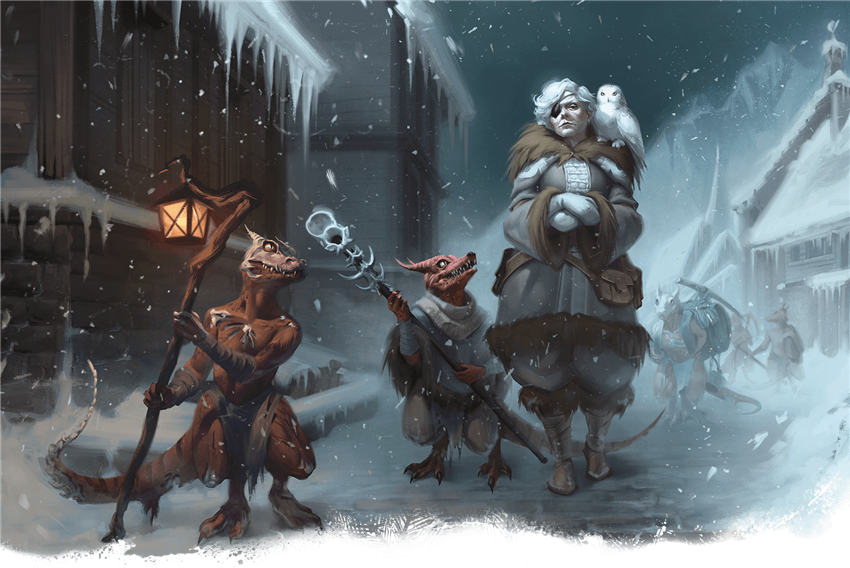
Creating Horror through Player Buy-In
D&D is a game of collective imagination. The more players want to be scared, the more likely they will dream up images that will scare them. Even players that don’t want to be scared a lot will have fun as long as they’re willing to be scared a little. One thing that you need to establish from the very beginning is that everyone you’re playing this adventure with will have fun being scared. If there are players that want to opt out of horror entirely, then all the hard work you’ve done with your voice and with the atmosphere will be for naught.
While playing D&D, emotions are a force multiplier. One person loving the horror is fun, but two people engrossed in the macabre is more than twice as fun, and three is more than three times as fun—and so on. If all of your players but one are loving the spooks, but that one person is adamantly opposed to being scared, it’ll bring down the overall fun of the group, not just their own fun. This isn’t to cast the anti-horror player in a villainous light; they’re just in a game that doesn’t suit their playstyle.
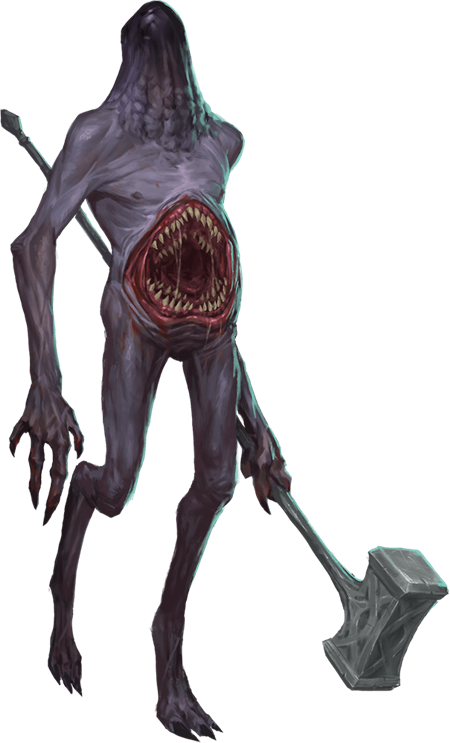 The best thing you can do to ensure that everyone has a good time from the start is to call a session zero and discuss what you and your players like about the horror genre and what you dislike about it. What horrific themes are fun for everyone to explore, and which ones are so deeply unpleasant that touching on them in-game would make the game worse. Icewind Dale: Rime of the Frostmaiden includes horrific elements including:
The best thing you can do to ensure that everyone has a good time from the start is to call a session zero and discuss what you and your players like about the horror genre and what you dislike about it. What horrific themes are fun for everyone to explore, and which ones are so deeply unpleasant that touching on them in-game would make the game worse. Icewind Dale: Rime of the Frostmaiden includes horrific elements including:
- Alien gestation (chestburster-style)
- Buried alive (under an avalanche or a cave-in)
- Brainwashing
- Freezing to death
- Inbreeding and deformities
- Longing for death
- Madness
- Missing limbs and extremities (from frostbite)
- Murder
- Possession
You may find other elements that you want to talk with your group about as you play through the game. Even though it “spoils” a big reveal, it’s worth holding a supplemental Session Zero to talk about new horrific content that you want to include to make sure that no one in your group has a major (or minor!) phobia that they haven’t told you about.
If you ever find yourself worrying that one or more of your players aren’t enjoying the genre of game you’re running, it may be incumbent upon you as the Dungeon Master to talk to them. Initiating conversations like this can be stressful, since you don’t want to come into emotional conflict with your friends, but calling up a new Session Zero and talking out any problems that you think have arisen will save you a lot of awkwardness and unhappiness in the long run.
Don’t Forget to Break the Tension
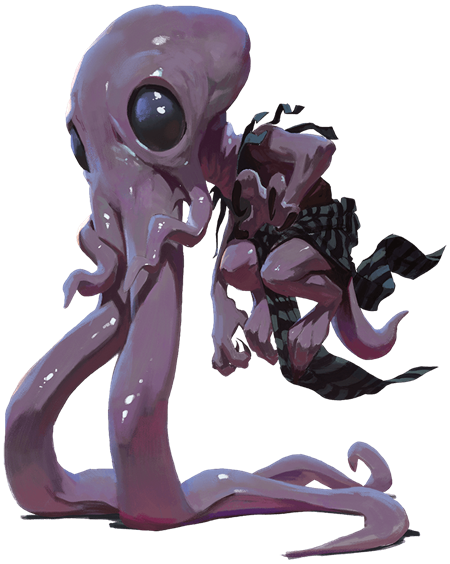 Don’t let your horror campaign become a dirge! If your campaign is a pressure cooker of tension and despair the entire time, you and your players will start to feel stressed out—and not in a fun way. Fortunately, it’s the natural state of D&D players to want to make jokes and have lighthearted fun while playing, and Icewind Dale: Rime of the Frostmaiden encourages those instincts every now and then by including moments of humor amidst the suspense.
Don’t let your horror campaign become a dirge! If your campaign is a pressure cooker of tension and despair the entire time, you and your players will start to feel stressed out—and not in a fun way. Fortunately, it’s the natural state of D&D players to want to make jokes and have lighthearted fun while playing, and Icewind Dale: Rime of the Frostmaiden encourages those instincts every now and then by including moments of humor amidst the suspense.
Finding the perfect balance between tension and levity is no easy task, and the correct ratio of each is different for every group—and every person! The only way you’ll be able to get it right is by trying things out and learning from your mistakes. You (or a friend) might break the tension just before a major reveal, and deflate a moment you worked hard for. This is a bummer, but unless it happens all the time, it’s not a problem. If your campaign is plagued by constant tone issues, it’s probably worth revisiting your Session Zero and talking this out with your players. Constantly breaking the dark tone of the story might be a sign that your players really just want to play a more lighthearted adventure—or, it could be a series of unfortunate tonal mismatches. The only way to know is to talk it out like friends.
What kind of spooky stories are you most excited to tell in your D&D campaign? Let us know in the comments!
Create A Brand-New Adventurer Acquire New Powers and Adventures Browse All Your D&D Content
 James Haeck is the lead writer for D&D Beyond, the co-author of Waterdeep: Dragon Heist, Baldur's Gate: Descent into Avernus, and the Critical Role Explorer's Guide to Wildemount, a member of the Guild Adepts, and a freelance writer for Wizards of the Coast, the D&D Adventurers League, and other RPG companies. He lives in Seattle, Washington with his fiancée Hannah and their animal companions Mei and Marzipan. You can find him wasting time on Twitter at @jamesjhaeck.
James Haeck is the lead writer for D&D Beyond, the co-author of Waterdeep: Dragon Heist, Baldur's Gate: Descent into Avernus, and the Critical Role Explorer's Guide to Wildemount, a member of the Guild Adepts, and a freelance writer for Wizards of the Coast, the D&D Adventurers League, and other RPG companies. He lives in Seattle, Washington with his fiancée Hannah and their animal companions Mei and Marzipan. You can find him wasting time on Twitter at @jamesjhaeck.








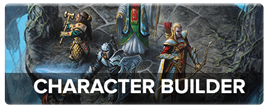
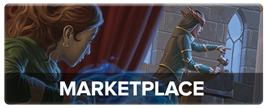
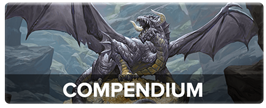
-
View User Profile
-
Send Message
Posted Sep 22, 2020bro
-
View User Profile
-
Send Message
Posted Sep 22, 2020My only problem: All but one of my players takes the game as only a game. If I presented them with a spooky moment, they simply treat it as just an enemy.
For Example:
think of the first Nazgul scene in Lord of the Rings. The thing is on the road, looking down over the heroes as they hide and fight it's influence over the ring. The heroes were scared and hiding. My players treat it as an enemy and attack it, even if that's not what they should be doing. I can't keep them in the suspense. Then the ones who are actually hiding help out. If I make the enemy too strong, they'll all die. When the fighting starts, all of the suspense dies with the players.
How do I fix this?
-
View User Profile
-
Send Message
Posted Sep 22, 2020The best thing you can do is to hold a Session Zero and tell them directly that this campaign may have encounters like the Nazgul on the road. Tell them that you want to include encounters filled with tension and suspense, and ask if they're interested in playing encounters like that. If they seem interested, that's awesome! The next step is to clearly signpost these encounters. You know how in that Nazgul scene, Peter Jackson uses a dolly zoom (that camera trick that seems to zoom in and out at the same time) to show that something unnatural is coming? In the film, that sets the audience's expectations that something horrific is about to happen. You need to do the same with your players to indicate to them that they're about to encounter a creature that's too powerful to fight. Use the techniques in the article above.
Of course, if your players tell you that they're not interested in suspenseful encounters like this, you've got to accept that this group just isn't into quite the same stuff as you. It's not worth trying to force them to have fun in a way they don't want to. That sucks a lot in the moment, but you'll find another group that you can do this stuff with someday!
-
View User Profile
-
Send Message
Posted Sep 23, 2020It feels like a lot of people wanted scary or disturbing horror and it's actually a bit more Sam Raimi inspired in a lot of ways. I think the marketing is off in that regard as it didn't set the correct tone for all the potential buyers. For me, the Thing does have some campy silly moments, along with a lot of the movies based on lovecraft. I think that message wasnt very clear to some. Like a talking walrus.
-
View User Profile
-
Send Message
Posted Sep 23, 2020What are the walrus references in the book? I know Walrus and Giant Walrus exist, but how are they featured in the book?
-
View User Profile
-
Send Message
Posted Sep 23, 2020They're animals. They show up as potential random encounters, mostly.
-
View User Profile
-
Send Message
Posted Sep 23, 2020This is gold.
-
View User Profile
-
Send Message
Posted Sep 23, 2020It is literally in a section about breaking up the tension. It is supposed to break up the horror.
-
View User Profile
-
Send Message
Posted Sep 23, 2020I'm working on a loosely-connected series of adventures based on Icewind Dale. I hesitate to say Campaign, as I would rather build it as something the characters are actually living through. Curse of Strand, and Tomb of Annihilation for instance are very much placed campaigns, and the characters slog through them with one ultimate goal in mind. Sure there are individual adventures, and side quests, but the main plot thread is hanging over them. As it is intended to do. I love them both. But I want to play up the "holy crap, we are in it now!" feel of Icewind Dale. The elements listed in the article and in some comments are paramount, isolation, fear of the unknown, all of these lead to the tension I want to build in each session. Sometimes that crunching in the snow is just a snow hare, and the party laughs to shake off that fear.
Now for my question, what movies, books, or even podcasts do folks consume to help put themselves in the mindset to create these adventure settings? One poster mention The Thing, and this is a great example of that isolation, and tension. Any more?
-
View User Profile
-
Send Message
Posted Sep 23, 2020So maybe my combining eye horror, tooth horror, and squick over the word 'moist' wasn't the most sensitive thing to spring on players... :D
-
View User Profile
-
Send Message
Posted Sep 23, 2020It's so much fun for them to wake up to find one of those has crawled inside their clothes while they sleep.
Though the 'corny-uncle' style practical joking necromancer using them for prank handshakes might not have been the most atmospheric use.
-
View User Profile
-
Send Message
Posted Sep 24, 2020There’s mo reason why you couldn’t swap out the squidlings with something that you feels is more suitable (like say, an actual mind flayer).
-
View User Profile
-
Send Message
Posted Sep 24, 2020Yep!
-
View User Profile
-
Send Message
Posted Sep 25, 2020I give my warmest recommendations to this sound tool
https://tabletopaudio.com/
Check the sound pad tool up to right menu.
-
View User Profile
-
Send Message
Posted Sep 25, 2020Wow, that is an amazing tool! Playing around with the ice planet soundscapes right now. Splendid!
-
View User Profile
-
Send Message
Posted Sep 26, 2020Horror Level of Icewind Dale: Rime of the Frostmaiden
COMPLETELY DEPENDENT ON THE DM
-
View User Profile
-
Send Message
Posted Sep 28, 2020Can't wait to get my hands on this campaign. Been a fan of horror since forever and this sounds just up my alley!
-
View User Profile
-
Send Message
Posted Sep 29, 2020Some really good advice here and definitely good material to help get the mood across. But I believe that's all you can really do with this material: establish a mood. To actually create terror, you need to go further. Since the player is "in the shoes" of the character, you need to scare the player to create terror in the player character. Otherwise, all the player is doing is ACTING like their PC is scared, which IMO, is not creating terror. It's creating acting. This is why I avoid selling my campaigns as "Horror" campaigns. It's a theme that never really works to 100% satisfaction. Either the spooks are too mild and achieve nothing but a chilling mood, or they're too wild and the threat of character death (or other dire fates) becomes an issue.
-
View User Profile
-
Send Message
Posted Sep 30, 2020I enjoy having an illusion over the horror itself and I enjoy slowing the game down when I feel that I can coordinate a jump scare, but when doing these things I look for ways of adding humor to the encounter too.
In Death House I placed a woman (stats of a hag or wight depending on my mood and the players) holding a baby (demon baby tiger stats with fiend properties) in the dining room and another woman (stats of a wight) in the kitchen. In this scenario I was able to slow the game down because one character was being extra cautions and walking around the whole exterior of the home before entering. I told the player that their character saw a sliver of light escaping out through a break between two heavy curtains covering the windows and that they perceived movement within the room, but to see anything more than that would require the character to get close, which they did, and I had them make a Perception check. The check was descent so I told them that there appears to be a woman holding a baby and pacing, but then she moved out of their view... until the woman's face can suddenly be seen popping into view right in front of your own before vanishing again, it appears that they know you are there.
Once inside the characters go to the dining room and begin talking to the woman who doesn't have any good answers to keep the players from getting suspicious. Just before the players reach that point of thinking the woman is lying, I describe the dining room slowly revealing a scene of gore and a body on the table and that the baby has the mouth and eyes of a shark and from the looks of things, it appears it was eating the body. At this point I pick the player that had the most revolted reaction and I have the woman toss the demon baby in their direction and I try to describe it as funny, because it's a baby being thrown at the players.
During combat I try to find moments to add humor and in one particular running of the game the player delivered the killing blow to woman and I had them slip a little in the gore and so did the woman, but the woman's head also hit the mantle causing her to flip over and land on her back as her legs flailed upwards into the air. I followed this up with the woman in the kitchen coming out o investigate, describing her as the cook and holding a long chopping knife that looked almost like a sword, her hair draped over her face so that you couldn't see what she looked like, but her hair was tangled in gore and her clothes were covered in it too. This woman walks into the room, tilts her head to one side, and then rushes toward the nearest character with her large wicked and possibly disease covered knife.
I will generally tell players that the game can be gory and that it will have a horror theme to it, I try to watch reactions during the game to make sure to dial things back if it appears to be going too far. Adding the humor to it helps counter those scary moments. Description and timing are everything and you sometimes you just can't force horror to happen in your players... I will often let up and watch the group for the mood to change and that's when I'll give it another try.
On the topic of another try, I had one game where the group was after a blue dragon and by the time they reached the dragon they were out resources and needed a long rest. Dragons are smart and it wasn't going to let them rest, I pestered them with small encounter after small encounter as creatures were sent to pester them. Then the dragon would have whirlwinds of sand pass by the corridor the players were in and they felt that the dragon was using those as cover to move about so the that characters wouldn't know where it was. The characters finally got flushed out and I figured it was going to end in a TPK, but with some good role-play, some quick thinking on making a deal using the knowledge they had learned about the dragon, and along with some well rolled persuasion checks, the players were able to make a deal with the dragon before it teleported them out of its cave. It then packed its treasure horde and moved to a different location in the desert mountain region. This wasn't really a horror moment, but it was a suspenseful moment because the whole group very well knew this could be the end of their character's story.
-
View User Profile
-
Send Message
Posted Sep 30, 2020@JaxomDM - wow, that's a great story! Thanks for sharing.